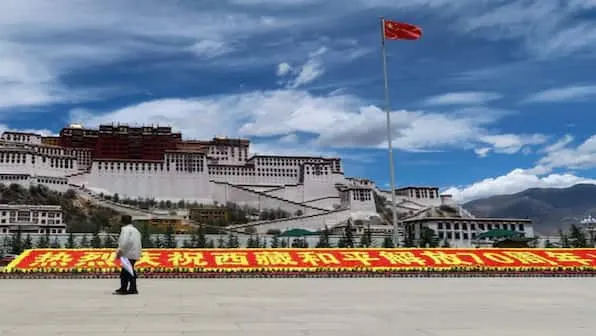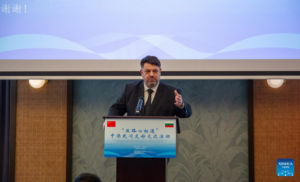China’s Deep-Sea Motivation for Claiming Sovereignty Over the South China Sea
In March of this year, over 200 Chinese marine militia ships gathered at Whitsun Reef in the Spratly Islands. Their presence was an ominous reminder of China’s intention to claim large swaths of the South China Sea, enclosed by the so-called “nine-dash line,” as its sovereign territory. Philippine officials sounded the alarm and reiterated the 2016 ruling of an international arbitral tribunal that denied the legality of China’s previous claims. Chinese officials dismissed the ruling and its implications and downplayed the military presence. But quietly, China continues to fortify a new and controversial presence in the South China Sea that risks triggering conflict. At least one American pundit is already warning of the risk of war between the United States and China.
Among the many issues at stake is the free and unlimited access to these international waters and the critical trade routes that run across them. These top-water issues are important and have drawn the attention of the largest navies in the world. China’s naval presence in the region has reached record levels with a plan for even more growth. The United States has enhanced its naval presence in the region as well, and President Joe Biden signaled his intent to maintain a strong presence in the Indo-Pacific. The European Union has released its long awaited Indo-Pacific Strategy, which re-emphasizes the need for free and open access to international waters and trade routes. The United Kingdom is sending a fleet of warships to the region that is its largest deployed fleet since the 1982 Malvinas/Falkland Islands War. Given all this intensification, one might wonder if we are experiencing the precursor to war.
A war in the South China Sea, however, is unlikely. These recent events are playing out in the latest chapter of what is becoming a very long playbook for China. Similar chapters have already unfolded in Mischief Reef, Fiery Cross Reef, and Subi Reef. Each time, China gradually asserts its presence and influence in disputed areas, like the Spratlys and Scarborough Shoal, wrapping “cabbage leaves” of sovereignty around these remote outposts while dismissing legal resolutions and avoiding large-scale conflict with a slow and patient approach we call strategic delay. We expect that China will continue on this course for the foreseeable future, relying on small-scale “gray zone” tactics to expand its reach in the South China Sea.
To see why, we need to look beneath the surface of what is happening now, both figuratively and literally.
China is aggressively competing with other global powers in what is becoming the great economic race of the 21st century: the quest to dominate the market for a cleaner alternative to fossil fuels. China has made no secret about its intentions to be a world leader in the production of batteries that will fuel the transportation needs of the future, power the sophisticated electronic devices that allow us to communicate and do business, and potentially reduce the extent of climate change. At the same time, China is aiming to become a leading global manufacturer of advanced electronics. With “Made in China 2025” as a key economic platform for President Xi Jinping, high-priority manufacturing sectors such as semiconductors, aerospace technology, and robotics are primed to expand and innovate.
Enjoying this article? Click here to subscribe for full access. Just $5 a month.
These batteries and advanced electronics rely on the cumbersome extraction and refinement of rare earth elements. Access to an ample supply of these rare earths will be critical to unfettered growth in these sectors in the coming years. In our research, we have found that a core strategic goal for China is to maintain its market power in the rare earths market. Over the last three decades China has dominated the market for the production and export of rare earths. Often producing well over 90 percent of the world’s consumption of rare earths, China has the market power to control the prices and the quantities of these essential commodities. Much like Saudi Arabia functions as the swing state in the world’s oil market, China can constrict or expand its exports of rare earths to maintain its preferred prices and supplies.
What does China’s role in the rare earths market mean for the politics of the South China Sea? China is currently facing two potential threats to its supply of rare earths. First, as China’s economy develops and its middle class evolves, the Chinese government likely anticipates a declining appetite for huge land-based rare earth mines at home. Second, China has successfully leveraged raw rare earth materials from states such as the Democratic Republic of Congo, but the long-term stability of access to these external sources remains an issue.
Diplomat Brief Weekly Newsletter N Get briefed on the story of the week, and developing stories to watch across the Asia-Pacific. Get the Newsletter
In response to these threats, China has begun to look offshore for a way to augment its supply of rare earths. The seabed of the South China Sea contains an abundant supply of small lumps of minerals known as polymetallic nodules. China has developed the most advanced deep-sea extraction technology in the world, and its ability to harvest polymetallic nodules and the rare earths within them is unparalleled. With the emerging mining code coming out of the International Seabed Authority, the best way for China to ensure continued access to these seabed minerals and an offshore supply of rare earths would be to treat these waters as sovereign territory.
If China’s goal is to control the supply and price of rare earths for at least the next quarter-century, fighting a war would be counterproductive. Indeed, China is quite familiar with the limits of its current market power over rare earths. In 2010, a Chinese fishing trawler in the East China Sea was seized by the Japanese Coast Guard after a collision near the Senkaku/Diaoyu Islands. The resulting dispute rattled the region, and China imposed a ban on rare earth exports to Japan as well as quotas on rare earth exports to the rest of the world. Huge price spikes of as much as 2,000 percent ensued, but what happened next is key.
The spike in prices and drop in supply attracted new entrants into the rare earth extraction business. The United States’ Department of Defense launched an inquiry into its reliance on Chinese minerals, and dozens of private firms launched into the market. In what became known as the “Rare Earth Crisis of 2010-2012,” China learned that constricting supply or raising prices too much would erode its own market position. By 2014, China had removed its quotas, restored exports to Japan, and prices dropped. The new entrants into the rare earths market faded away, but the threat of their reemergence lingers.
With that lesson learned, China’s goal is not to deploy its market power to erode global access to rare earths. Instead, we expect that China aims to ensure a steady and stable supply of rare earths for an expanding domestic need while continuing to dominate the global market. If China can guarantee plentiful and low-cost rare earths for its own manufacturing needs, it will be well-positioned to succeed in its ambitious economic efforts in the coming years. Profits gained from the global market make it easier to subsidize China’s domestic needs.
As such, we do not expect these confrontations to go away anytime soon, just as we do not expect any of them to trigger war. China’s market power goals will continue to motivate it to gradually expand its maritime reach and reassert its claims in the South China Sea. At the same time, as its rejection of the 2016 Permanent Court of Arbitration ruling demonstrates, any proposed solution to these repeated territorial disputes that ignores the economic imperative of China’s rare earth market power is likely to fail. No matter how tense things seem to get on the surface, the economics of what lies beneath cannot be ignored.












